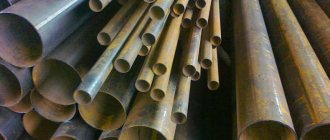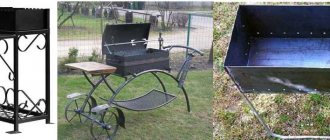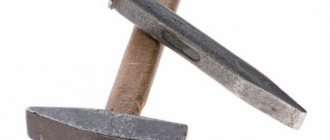In most cases, the sewer system is gravity-fed. This means that all drains leave on their own, under the influence of gravitational forces. But in order for them to move, the pipes must be laid not level, but with a slope, and with a certain one. We will talk further about what the slope of the sewer pipes should be.
Sewer pipes cannot be laid straight
Types of sewer systems
There are two types of sewer systems based on the method of moving wastewater - gravity and pressure.
Gravity sewerage uses the principle of moving wastewater in the direction of discharge under the influence of its own mass. The movement is provoked by the inclined location of the pipeline. This is the most common type of sewer system.
Scheme of gravity sewerage using a septic tank
Pressure sewerage moves wastewater forcibly using a pump. The fecal pump raises the waste mass to the desired height. Pressure sewerage is used in cases where it is impossible to position the pipeline at the required slope, and accordingly, gravity discharge is impossible.
Scheme of drainage of a residential building using pressure sewerage
Reasons for replacing a gravity sewer with a pressure one:
- The collector pipe is located below the level of the centralized sewer network. A similar situation arises when the building is located in a low-lying area or there are waste disposal points in the basement, for example a swimming pool or sauna.
- The house was built on a site with uneven terrain (hills, folds of terrain). The connection to the terrain makes it impossible to lay the pipeline at the required slope.
- According to technical conditions, it is necessary to use pipes of a smaller diameter than required in accordance with the calculations. In this case, when discharged by gravity, water takes a long time to pass through and the sewer becomes clogged.
- The characteristics of the soil do not allow digging a trench of the required depth for the collector.
The cost of equipment and operating costs of pressure sewerage are higher compared to gravity sewerage. For the system to function properly, electricity and high-strength pipes are required. For this reason, gravity sewerage is preferred if conditions exist for its installation.
Execution of work
To dismantle the old sewer you need:
- identify difficult areas where additional work will be needed. For example, the place where the pipeline passes through the wall;
- Use a chisel to dismantle old pipes. Cast iron particles must not be allowed to enter the main line;
- If you don’t need to change the main riser, then saw off the pipe using a grinder.
- After dismantling, work stops until the connecting parts cool completely.
As for installing a plastic pipeline, there are two ways. The first is based on installation using glue:
- cut pipes to the required lengths;
- clean the edges with sandpaper and degrease;
- apply glue in necessary places;
- connect;
- leave until completely dry - 1 hour.
Second way:
- cut pipes, clean them;
- heat the soldering device to 260 degrees;
- fix the connector and pipe on the soldering iron;
- connect in heated places;
- check the seams.
Why do you need to calculate slope?
The slope of the pipe should ensure rapid drainage of water and the absence of deposits. If the slope is insufficient, the drains do not flow well and the pipe will quickly clog. If the pipeline is inclined in the opposite direction relative to the direction of discharge, the gravity system is completely inoperative.
Sewer pipe clogged with sediment
The decision to place the pipeline at the maximum angle of inclination seems obvious only at first glance. A pipe that is too inclined is poorly filled and the transport capacity is sharply reduced. The waste stream passes so quickly that the water does not have time to capture the denser fractions that are deposited on the walls. Due to insufficient pressure, bulky debris gets stuck. Gradually the pipeline silts up and becomes clogged.
How not to lay sewer pipes
In addition, when draining quickly, due to a sharp pressure drop, water is literally sucked out of the water seals of the plumbing fixtures. Unpleasant air from the sewer enters the premises.
Water seal in the drain hose under the kitchen sink
There is another negative effect of underfilling the pipe. The additional influx of released corrosive gases to metal surfaces causes accelerated corrosion and a reduced service life.
Joints between tiles
In order to make the inspection hatch under the tile as inconspicuous as possible, you need to pay attention to this nuance. After the installation of the structure into the surface is completed, the tiles on the hatch cover are glued and processed, the hatch is closed
Then the seams that are located between it and other tiles must be filled with silicone. This is done to ensure maximum invisibility. Before application, you first need to cover the contours of the adjacent tiles with masking tape, and then only fill the seams with silicone. After it hardens, you need to carefully draw a sharp object along the contour of the tape, and then peel it off. You will get a neat inner seam.
To ensure access, the following is done. Using a utility knife, cut the silicone at an angle along all sides of the structure.
Please note that cutting must be done as carefully as possible, as there is a high risk of ruining the seam and scratching the tile
What should the slope of the sewer pipe be?
Standard slope values for gravity pipelines are calculated using formulas from SP 40-102-2000 or established using tables in Appendix B to SP 40-107-2003. As the diameter increases, the standard slope values become smaller.
This parameter shows how much the position of the pipe changes in height per 1 linear meter. For practical purposes, this unit of measurement is more convenient than degrees.
Recommended slope values for pipes of different diameters
The actual slope is calculated using the formula:
where i is the slope, ∆hв is the height difference at the ends of the pipe in m, l is the length of the pipe in m.
The slope is also measured as a percentage. To convert to percentage units, the fractional value must be multiplied by 100%.
To keep the sewerage system in working condition, the actual value must correspond to the standard value. Knowing the required slope and length of the pipe, you can calculate the height difference at the ends of the pipe.
Example
The slope of a 50 mm sewer pipe is 0.03, which corresponds to 30 mm per 1 linear meter. The total length is 6.7 m. Calculate the height difference along the entire length.
Thus, the pipe must be installed with a height difference at the ends of 0.201 m, or 20.1 cm. When converted to percentages, 0.201 × 100% = 20.1%.
Laying a pipeline with a different inclination angle on separate sections is unacceptable. In this case, some areas will become silted.
Additional recommendations
During the design and installation process, you need to pay attention to a few more points:
- Natural shrinkage. The soil can be compacted under the influence of external factors, resulting in a change in slope.
- In some areas, it is advisable to install inspection hatches at intervals of 30-40 cm in case of clogging due to poor outflow. For the same purpose, specialists connect pipes at an angle of at least 120°.
- Calculations are carried out starting from the outlet point of the sewer, but installation always occurs in the reverse order - in the direction from the drain well.
- The project is designed so that the line length is minimal. The shorter the line, the less likely it is to become clogged or break down.
The correct location of sewer drains allows you to avoid blockages and ensure a long service life of all communications.
The best option for calculations is to focus on SNiP standards and take into account the individual characteristics of the building and the location of the bathrooms. Upon completion of installation, before digging the trench, all elements of the main line are checked for tightness and reliability of outflow.
Filling level
The diameter and angle of the pipe affect the level of filling with wastewater. With an increase in these parameters at a constant volume of wastewater, the water content decreases.
The filling level Y is determined by the following relationship:
where hс is the height of the drainage level in the pipe in m, d is the diameter of the pipe in m.
A fill level indicator of 0 indicates that the pipe is empty. An indicator equal to 1 indicates complete filling.
The pipeline should not be 100% filled; partial filling ensures the removal of accumulated gases. There is also a reserve for the passage of additional unaccounted volume of wastewater. The minimum permissible filling level is 0.3.
In addition to the actual filling level Y, there is an optimal one (denoted K). At an optimal filling level, the gravity pipeline operates in self-cleaning mode.
The optimal filling level for pipelines made of polymers is 0.5, for pipelines made of other materials – 0.6.
The difference in values is explained by the fact that deposits settle more strongly on the rough walls of pipes made of asbestos-cement or cast iron. To self-clean the pipeline, a more powerful flow is needed.
The relationship between the optimal (K) and actual (Y) filling level is as follows:
where V is the speed of movement of wastewater in m/s.
The average speed of passage of wastewater must be at least 0.7 m/s. When the flow moves at such a speed, solid inclusions remain suspended and do not stick to the walls.
Example
With a slope of a 110 mm plastic sewer pipe equal to 0.02 and a filling level of 0.7, the flow moves at a speed of 0.733 m/s. Check whether the relationship between the optimal and actual filling level is satisfied.
For plastic, K is 0.5. Since 0.5≤0.61, the relation is satisfied.
Maintaining the angle
The angle of inclination is half of the work. The main part is due to the maintenance of this indicator during the installation of the sewer system. Craftsmen use a special protractor.
If the protractor does not work, there is no way to get one; specialists make do with a simple level. There are a couple of methods:
- Draw a line on the wall corresponding to the degree of slope. Attach a building level and make marks in the area of the bubble. The pipe is installed relative to the position of the mark. The method is not ideal, as it allows for errors;
- attach a special pad to the meter level. The last element will correspond to the angle of inclination.
Slope when installing internal sewerage
The internal sewerage system includes part of the general sewerage system from the waste discharge points inside the building to the first well in the external network. This includes bends, risers and headers (outlets). Branches connect siphons of plumbing equipment with vertical risers, and collectors receive wastewater from risers and discharge them into the external sewer network. When installing bends or collectors, it is necessary to place the pipe at an angle.
General scheme of internal sewerage
The slope of the reservoirs is in the range of 0.01–0.05. The optimal value is 0.02. The slope of the bends is 0.01–0.05 for unventilated bends and at least 0.005 for ventilated ones.
The maximum slope is 0.15 (except for branch pipelines up to 1.5 m long). In mined areas, the angles of inclination of branches and collectors are set taking into account the expected settlement of the earth's surface.
Preparing for work
For installation you will need:
- plastic pipes with a cross-section of 5, 10 centimeters;
- connecting elements;
- cuffs to seal joints;
- glue for plastic;
- cement mortar;
- roulette;
- saw;
- level;
- marker.
When reconstructing an old sewer system, you need to study the features and layout plan in advance. Draw up an installation diagram. This action does not need to be performed if a new sewer system is being installed.
- A drawing should be displayed on paper, with fixed wiring locations and a bathroom. It is necessary to mark the riser and determine the distance.
- Check that the drawn diagram matches the existing one.
- Carry out calculations. Calculate the amount of material needed.
Organization of slope in a private house
The volume of wastewater in a country house is significantly less than in an apartment building. Under these conditions, even with a minimum slope determined from a hydraulic calculation table or formula, the filling level will be insufficient for self-cleaning of the pipe.
It is impossible to reduce the slope even more, since the flow rate will become too slow. Sand with other solid inclusions will settle to the bottom, and the pipe will probably clog. In such a situation, the required angle of inclination of the pipeline is determined by a non-calculation method.
Non-calculation method for determining slope
According to regulatory documents, the non-calculation method is used in cases where, due to the small volume of wastewater, it is impossible to fulfill the condition for the relationship between the optimal and actual filling level.
The old version of SNiP 2.04.01-85 set out the following recommendations on slope for undesigned sections of gravity pipelines:
- Pipe diameter 40 or 50 mm – 0.03
- Pipe diameter 85 or 100 mm – 0.02
The updated version of this SNiP, set out in SP 30.13330.2016, suggests that the minimum slope value for non-calculated sections of the pipeline should be considered equal to 1/d, where d is the outer diameter of the pipe in mm.
Recommendations from specialists for laying a collector from an individual country house to a septic tank:
- A medium-sized house with two bathrooms - 110 mm pipe with a slope of 0.02
- House with three or more bathrooms - 160 mm pipe with a slope of 0.08
Compliance with the proposed parameters preserves the transporting capacity of the liquid flow in the pipeline.
Slope check
The best device for checking the angle of inclination is a level. The device measures the depth of the trench under the pipeline at control points, and the difference is compared with the required value. If there is a deviation from the calculated value, the trench depth is adjusted.
To check the slope without a level, use a simple method using available tools. Two pins are inserted into the bottom of the trench at both ends. The cable is pulled between the pins and the horizontal position is checked using a building level. If necessary, leveling is done.
Then, near both pins, measure the height from the bottom to the cable. After determining the magnitude of the difference, proceed in the same way as in the situation with a level.
In the figure below, the initial depth of the trench is 0.5 m. Based on the recommended slope of 0.02 for a 110 mm pipe, we obtain:
We add the calculated depth difference of 0.6 m to the initial depth of 0.5 m and obtain a trench depth at the end point of the pipeline of 1.1 m.
Solving the problem of a steep slope
If in the direction of laying communications the steepness of the slope exceeds the standard slope, then at some point the more gently located pipeline will come to the surface. The problem can be solved in two ways.
The first option is to make vertical decreasing sections in the pipeline as it approaches the surface. In the second option, a large vertical depression is immediately made, which is enough for the entire length of the collector.
Downgrade scheme according to the first and second options
Peculiarities
The norms and rules for design and construction are contained in SNiP. Recommended actions related to sewerage construction work must be followed. Particular attention should be paid to organizing the slope in a private house. Internal and external drainage systems will differ in the types of pipes used and the designed slope.
The options for pipes used when installing sewerage systems inside the house are 50 mm, and outside – 110 mm. At the places where devices are connected, the planned main line should be smaller in diameter. Devices are plumbing fixtures that can be installed in an apartment: sink, bathtub, toilet. Of all devices, the outflow must be timely, and this will ensure a properly designed slope.
The best arrangement option, used by professionals, is one in which the drains drain themselves. The method is suitable for installing systems in high-rise buildings and in private houses. In this case, horizontal pipes with a calculated slope angle should be installed correctly after the fixed risers. Considering that the vertical branches of the sewer system are characterized by increased dimensions in comparison with other pipes, the horizontal branches are connected to them with fittings. In the direction of the devices, horizontal pipes should be laid along the shortest path.
If this condition is met, the likelihood of a blockage will be minimal. Another feature of sewer systems is that the smaller the pipe diameter chosen for the system, the greater the slope will have to be created. The difference in height is taken into account at the highest point - this is the beginning of the system, and at the lowest point - this is the end of the entire mounted system.
The slope is calculated per linear meter; this value must be observed for the entire length of the system. If you do not adhere to it, the entire drainage system will need to be redone.
When calculating per linear meter, the diameter of the pipes is taken into account.
- for drainage with a diameter of 40-50 mm, the slope is 3 cm per meter;
- for drainage with a diameter of 85-110 mm, the slope is 2 cm per meter.
Storm drainage of buildings and its slope
Storm sewers, or storm drains, serve to collect and drain water that falls in the form of precipitation. The storm drain is designed to protect the building from unpleasant consequences - erosion of the foundation, flooding of the basement, flooding of the adjacent territory, waterlogging of the soil.
Storm and domestic sewage systems operate separately; according to SNiP standards, integration into a common network is prohibited. In a closed-type storm sewer, the water flowing onto the ground flows through storm water inlets into a network of underground pipelines, from where it is discharged into the centralized sewer network or nearby reservoirs.
The storm drain is filled extremely unevenly; during periods of peak load, the amount of drainage increases sharply.
Rules for laying storm drains
The pipes are connected both straight and at an angle. If the site has a slope in the direction opposite to the discharge, 90° elbow fittings are used to compensate for the difference in ground level.
Compensation of height differences with fittings
For storm sewer pipelines with a diameter of no more than 250 mm, the maximum filling level is 0.6.
The minimum speed of movement of drains for storm drains with a period of one-time excess of the calculated rain intensity of 0.33 years is 0.6 m/s. The maximum speed for pipes made of metal, polymers or glass composite materials is 10 m/s, for pipes made of concrete, reinforced concrete or chrysotile cement – 7 m/s.
Standardization of the angle of inclination of the sewerage system per 1 linear meter
It seems natural to believe that exceeding the slope of the internal sewer can only have a positive effect, in which the wastewater reaches the collector faster.
But if water passes through the pipe too quickly, fibrous and solid inclusions are deposited on its walls, which gradually lead to blockages. Cleaning such a plug mechanically leads to a deterioration in the quality of the inner surface of the pipes, which aggravates the situation with free flow. The life cycle of such drain systems, as a rule, does not exceed one year.
The angle of inclination of a sewer pipe per 1 meter for pipes of different sizes has different standard values.
To get a complete picture of the operation of the domestic wastewater sewer system, we will follow the process from start to finish.
What rules must be followed when determining the slope?
Summarizing what has been said, we can draw up a list of basic rules regarding the angle of inclination for a sewer pipe.
List of rules:
- Sloping in horizontal sections is necessary only for gravity-flow pipelines.
- Both too small and too large an angle of inclination negatively affect the throughput of the sewer system.
- In most cases, recommended slope values are in the range of 0.01–0.05. The optimal value is 0.02, the maximum is 0.15.
- When laying a pipeline, one must strive for the optimal filling level of the pipe.
Before starting work, it is recommended to draw a network profile with basic data for laying the pipeline and for the future sewer system. Instructions for the content of this document are specified in GOST 21.604-82.
When it is impossible to maintain the desired tilt
When installation is accompanied by difficulties and it is not possible to maintain the correct angle of inclination, take the following actions:
Calculations that are within the permissible deviations can be used when laying a sewer system. It is important to make additional tees at a certain distance. Cleaning will be carried out through them.
In difficult areas, make elevation changes. Organize them by installing additional wells. With their help, lay communications properly, observing fixed standards. The number of wells may vary. From one to several. Depending on difficult cases, the length of the sewer.
If it is impossible to maintain standard indicators and the operation of the system will not be ensured properly by gravity, then you need to install a fecal pump. The device is suitable both for a specific sewer branch and for the entire system as a whole.
When laying plastic pipes, owners will be sure that cleaning will occur much less frequently than in the case of a cast iron system. Plastic pipes have a smooth inner surface, which ensures rapid sliding of drains. Cast iron does not have a perfectly smooth surface. Due to the presence of small notches and particles, waste will stop and grow faster.
What does it depend on?
Based on the table below, the slope is associated not only with the diameter of the products and the footage of the sewer, but also with special conditions.
| pipe diameter, cm | slope per meter | slope under special condition |
| 15 | 0,008 | 0,007 |
| 20 | 0,007 | 0,005 |
Special conditions under which a slope can be installed include factors such as:
- product material;
- method of drainage arrangement;
- pipe throughput property.
The quality of a pipe to pass liquid through itself is closely related to the material of its manufacture and size. The designation of this property cannot be found on the label, so you will have to calculate it yourself.
The complexity of the calculations lies in the fact that for each individual case you need to use your own appropriate methodology. An important parameter used in the calculations is the outer size of the pipe. In formulas it can be denoted by the Latin or Russian abbreviation “Dn” or “Dn”.
There is a table with approximate information that will facilitate the task of determining the throughput of systems. High-precision calculations in most cases of home sewerage installation are often not required. Values for a pipeline line equal to 1.5-3.0 m/s can be used without fear of violating standards. The table also includes information about other types of gas and water pipelines.
The sewerage capacity is closely related to the type of pipeline being installed. The main line can be pressure or non-pressure. Standard calculation formulas include the laws of hydraulics.
The following unknowns are taken into account in hydraulic formulas:
- line diameter;
- average flow rate;
- hydraulic slope;
- filling level.
In fact, it is often enough to know the hydraulic slope I or h/d. The first indicator is correctly considered identical to the slope of the base.
Speed values for domestic drainage systems can be studied in the table below:
| Du, cm | h/ Du | self-cleaning speed, m/s |
| 15-25 | 0,6 | 0,7 |
| 30-40 | 0,7 | 0,8 |
| 45-50 | 0,75 | 0,9 |
| 60-80 | 0,75 | 0,1 |
| 90 | 0,8 | 1,15 |
The minimum slope indicator for a small sewer is i=0.008, 0.007. The necessary indicators of the throughput of various products from 5 to 200 cm are in special professional tables. The indicators are directly related to the maximum network load, as well as the average speed of wastewater movement. The value demonstrating the maximum load on the pipe is measured by the H/d indicator.
For example, in the table h/D is the pipe load;
- V – flow velocity;
- Q – flow rate.
The choice of the right type of system is based on technical feasibility and sanitary conditions. The system adopted as a basis must meet all requirements and technologies.
Introduction
In order for the system to work normally, the following factors must be observed:
- cross-section and material from which the pipes are made (PVC casing with threads for wells),
- type of their wiring (internal or external).
What does the concept include: pipe angle?
If you mentally draw perfectly straight horizontal lines through an already installed pipeline, you will get a geometric angle.
To measure it, we do not use the degrees we are accustomed to. The angle that provides the most favorable slope of the highway, according to the set of regulatory documents, is recommended to be measured in centimeters per meter.
Perhaps such a measurement system may seem quite complex and unusual to some, but this is only at first glance.
In reality, it simply shows how many centimeters one end of a meter-long hollow object should be higher than the other.
As usual, the slope of a sewer pipe is calculated as a simple fraction or decimal digits.
For example:
120 will correspond to a slope of 5 centimeters (one meter divided by 20 centimeters).
In decimal expression it would look like this - 0.02.
Many homeowners do not consider it necessary to take care to make the highway slope optimal.
They think that with the maximum slope of the pipes, the drains, for example, from a country washbasin (with heating) will drain much faster.
This statement only applies to clean water.
And in sewage there is a huge amount of impurities of various fractions, which have different densities; accordingly, they move through the pipeline at excellent speed.
It is for this reason that you should not make either too small or a very large bevel of a hollow sewer object, which will adversely affect the efficiency of the system as a whole.
Professional design
In addition, if the owner of a private residential plot has the right to make a mistake, he can design a sewer system at his own peril and risk
To organize even a small enterprise, to draw up plans for the improvement of urban or courtyard areas, carefully calculated, technically sound projects are required that fully comply with all existing sanitary and construction standards.
Such design and survey work is carried out by special organizations that have state certification to carry out activities of this kind
.
When contacting specialists, the customer presents them with a number of documents that will form the basis of the technical specifications:
- Topographical diagram of the territory from which stormwater is expected to be drained.
- Geological survey data containing information about the nature of the soils on the site.
- General development plan.
- If you plan to discharge into a centralized collector system
, the technical conditions of the water utility services for connection. - Sanitary standards for water purification if it is intended to be discharged into natural reservoirs or drainage fields.
- Possible customer wishes for organizing the accumulation of collected water.
The result of the designers’ work is a package of documents, which includes:
- General information about the site being developed and storm drainage.
- Detailed schematic diagram of storm drainage.
- A scaled drawing-plan of the site with reference to the locations of all elements of the storm drain. In essence, it is a ready-made installation instruction for further work.
- Detailed specification of the equipment required according to the technical specifications.
- A full estimate for the purchase of the required materials and construction, installation and commissioning works.
The finished storm sewer project is subject to mandatory approval from water utility companies, state technical supervision authorities, the sanitary-epidemiological service, and the environmental control service in charge of the state of water resources.
Only after the project has been fully approved by all regulatory authorities can its practical implementation begin.
Some design organizations take on the entire process of approving the project they have developed.
The design process is complex, but there are no trifles in this matter.
In order for the storm sewer to fully fulfill its functions, so as not to incur penalties for violations of environmental legislation, it is better to entrust the development of the project to experienced specialists whose qualifications are not in doubt.










